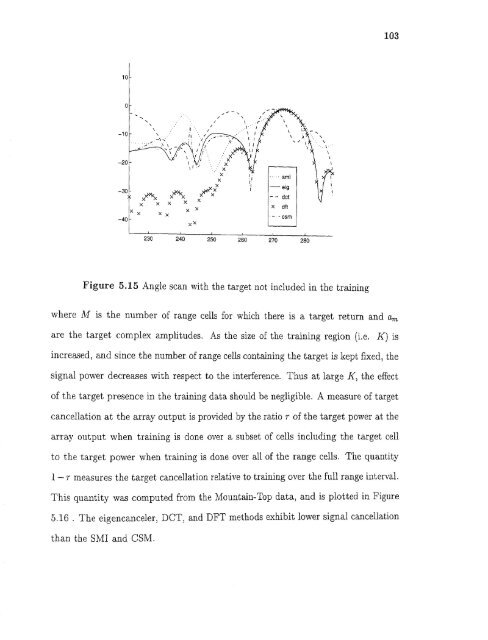Space/time/frequency methods in adaptive radar - New Jersey ...
Space/time/frequency methods in adaptive radar - New Jersey ...
Space/time/frequency methods in adaptive radar - New Jersey ...
You also want an ePaper? Increase the reach of your titles
YUMPU automatically turns print PDFs into web optimized ePapers that Google loves.
103Figure 5.15 Angle scan with the target not <strong>in</strong>cluded <strong>in</strong> the tra<strong>in</strong><strong>in</strong>gwhere M is the number of range cells for which there is a target return and a mare the target complex amplitudes. As the size of the tra<strong>in</strong><strong>in</strong>g region (i.e. K) is<strong>in</strong>creased, and s<strong>in</strong>ce the number of range cells conta<strong>in</strong><strong>in</strong>g the target is kept fixed, thesignal power decreases with respect to the <strong>in</strong>terference. Thus at large K, the effectof the target presence <strong>in</strong> the tra<strong>in</strong><strong>in</strong>g data should be negligible. A measure of targetcancellation at the array output is provided by the ratio r of the target power at thearray output when tra<strong>in</strong><strong>in</strong>g is done over a subset of cells <strong>in</strong>clud<strong>in</strong>g the target cellto the target power when tra<strong>in</strong><strong>in</strong>g is done over all of the range cells. The quantity1 — r measures the target cancellation relative to tra<strong>in</strong><strong>in</strong>g over the full range <strong>in</strong>terval.This quantity was computed from the Mounta<strong>in</strong>-Top data, and is plotted <strong>in</strong> Figure5.16 . The eigencanceler, DCT, and DFT <strong>methods</strong> exhibit lower signal cancellationthan the SMI and CSM.
















